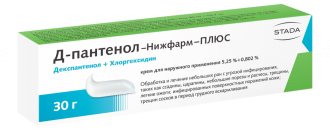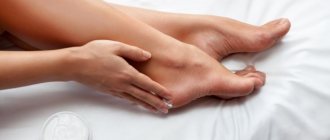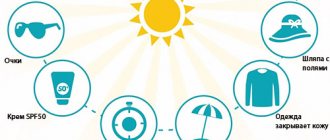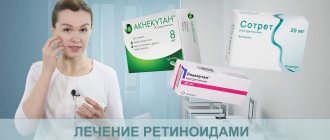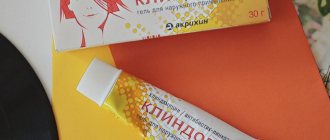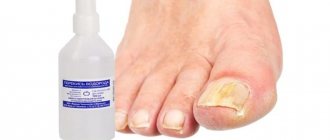Dexpanthenol is a substance derived from the water-soluble B vitamin - pantothenic acid. It is this that the body’s need increases when the skin and tissues are damaged. To compensate for the lack of substance and accelerate cell regeneration, use the topical drug D-Panthenol.
Types of dosage forms, composition
D-Panthenol is available in the form of ointment and cream. 1 g of both forms contains 50 mg of dexpanthenol.
D-Panthenol cream has a white color, a uniform structure, and no pungent odor. It is packaged in tubes of 25 or 50 g, which are sold in boxes with instructions. Additional ingredients include propylene glycol, methyl parahydroxy- and propyl parahydroxybenzoate, macrogol cetostearate, cetostearyl alcohol, paraffin, petroleum jelly, sodium hydrogen phosphate dodecahydrate, potassium dihydrogen phosphate, purified water.
D-Panthenol ointment has a white color with a yellowish tint, a thicker structure and a faint odor. It is packaged in 30 g aluminum tubes, which are placed in a box complete with instructions. In addition to dexpanthenol, it contains glycerin, lanolin, petroleum jelly, liquid and solid paraffin, stearyl and cetyl alcohols, and water.
Panthenol: composition
The active ingredient in panthenol cream, spray, ointment or balm is called dexpanthenol. The drug is available in different forms (cream, ointment, spray).
!
All these products are suitable for external use only.
Panthenol cream contains 5% active substance (50 mg per 1 g of cream). The remaining share comes from auxiliary components. The cream is produced in tubes of 25 and 50 grams. This is a homogeneous white product with a neutral aroma. Panthenol helps with cracked nipples in nursing women, stretch marks during pregnancy, scars, etc. It is also used for hemorrhoids (Haemorrois) as an aid.
Panthenol ointment also contains 5% of the active ingredient, but differs in the composition of the auxiliary components. It is a homogeneous yellowish substance with the aroma of lanolin. Panthenol ointment is used to treat very dry skin, trophic ulcers, bedsores, and wound surfaces. It is also produced in tubes of 25 and 50 grams.
Panthenol spray with a percentage of 4.63% of the active ingredient is most often used for sunburn. It is produced in aluminum cylinders of 58 and 130 grams.
Indications for use of D-Panthenol
Everyone needs to know what D-panthenol ointment is used for. The main reasons for use are a variety of mild skin damage resulting from temperature, mechanical or chemical exposure. Indications include:
- skin burns, including those resulting from sunburn;
- wounds in the form of abrasions and scratches;
- dermatitis;
- uncomplicated diaper dermatitis in infants and its prevention;
- treatment and prevention of nipple injury during breastfeeding;
- dryness and tightness of the skin
Depanthenol cream is used to protect the epidermis from the effects of frost and wind, for the prevention and treatment of diaper rash, when treating the skin around the openings for the removal of colostomy, tracheostoma or gastrostomy.
The ointment is used in the treatment of bedsores, trophic ulcers, anal fissures, and non-infected wounds after surgical interventions.
IN
Diaper dermatitis is an irritation of the skin of the gluteal region or inner thighs in infants and young children caused by physical, chemical and microbial factors [3, 9, 11, 12]. According to various authors, diaper dermatitis develops in children in 30–70% of cases [1, 5, 2, 8, 9]. It usually occurs in children aged 3 to 12 months, more often in girls [2, 4, 7]. Diaper dermatitis is much more common in children suffering from atopic or seborrheic dermatitis. Breastfed children are much less likely to suffer from diaper dermatitis compared to children receiving artificial formula, this is explained by the lower enzymatic activity of feces during natural feeding [6, 10, 12]. Diaper dermatitis sometimes develops even with good care of the baby's skin, for example in the case of diarrhea, switching from liquid to solid food, or stopping breastfeeding.
Before moving on to considering the causes of diaper dermatitis, it is necessary to once again pay attention to the physiological characteristics of the child’s body. The skin is the first barrier to the penetration of bacteria and toxins into the body. The skin also protects the child’s body from temperature fluctuations, mechanical stress, and at different periods of childhood it has morphological and functional characteristics that make it especially vulnerable and vulnerable to various environmental influences.
The three-layer structure of the skin is characteristic not only of adults, but also of children [1, 4, 11]. The first (outer layer) is the epidermis
, in turn, is divided into basal, spinous, granular and stratum corneum.
The stratum corneum consists of 2-3 rows of keratinized cells, which are constantly rejected and replaced by new ones. It is known that the process of skin renewal completely takes about 25–30 days [2, 5, 8, 11]. The skin of a newborn is at risk because the outer layer is looser and its cells are very easily exfoliated and damaged. The dermis, the basis of the skin, consists of papillary and reticular parts and poorly developed connective tissue. This layer contains blood and lymphatic vessels, nerve endings, hair papillae, sebaceous and sweat glands. The skin is elastic due to the interweaving of collagen and elastin fibers; it is the insufficient development of collagen and elastic fibers that reduces the natural shock-absorbing ability of the skin in children [3, 5, 10]. Infants have 12 times more sweat glands than adults [1, 9, 12]. The process of sweating begins first on the face (from the 2nd–5th day of life), then on the palms and other parts of the body. Fully sweat glands are formed only by the age of 3, which is explained by imperfect innervation of the skin of newborns [11, 12]. It is interesting that the number of sebaceous glands is 4–8 times greater than in adults, but by the age of 2 their function decreases and increases only by adolescence. Subcutaneous tissue protects the skin
from mechanical and thermal damage .
It is formed from adipose tissue and collagen fibers. The low activity of the local immunity of the child’s skin leads to its slight vulnerability. The macrophage system of the epidermis and dermis, including Langerhans cells and histiocytes [1, 3, 7, 12], provides antimicrobial properties. But at the same time, the bactericidal activity of skin neutrophils in young children is not sufficiently developed [5, 9]. The immaturity of cellular and humoral immunity in young
children After the birth of a child, active microbial colonization of his skin begins, mainly with staphylococcal flora, which is part of the normal microflora of the child’s skin. High humidity and low acidity of the baby's skin can promote excessive growth of various microorganisms on its surface, including staphylococci [3, 4, 7]. The respiratory function of the skin in children is more active than in adults. Gases easily diffuse through the wall of numerous skin vessels. Contamination of the skin excludes it from the process. The infant's skin receptors provide tactile, thermoregulatory and pain sensitivity. Under the influence of sunlight, the skin synthesizes the pigment cholecalciferol [4, 6, 11]. Excessive contamination of the skin impairs its functions and leads to irritation of sensitive receptors, which causes anxiety for the child.
All these features lead to more frequent mechanical damage and possible infectious and allergic inflammation. Therefore, proper care of a child’s skin is care for the prevention, first of all, of inflammatory diseases. The integrity and preservation of the protective functions of the skin are very important.
So, the goal of skin care for young children is to ensure normal microbiocenosis and prevent irritation and damage to the epidermis.
To cleanse the skin of a newborn and young child, use water and special grades of pH-neutral baby soap, and choose special detergents without alkaline components.
With frequent bathing and the use of cosmetics, children's skin becomes dry, cracks appear in the stratum corneum, and irritation reactions intensify in the form of redness and fine pityriasis-like peeling. In children predisposed to skin diseases, especially such as seborrheic and atopic dermatitis, in such cases water-oil emulsions, baby and cosmetic milks can be used. Using powder and cream on the same areas of the body can lead to maceration of the skin. Oils that protect the skin from dehydration and degreasing are recommended for the bath. Baby soap with lipid additives provides a cleansing, degreasing, but at the same time hydrating effect. To wash hair, use a special children's shampoo that does not irritate the mucous membrane of the eyes. Constant care is necessary for the child's perineal area, as it is in constant contact with moisture and metabolites excreted in the urine. For the prevention of diaper dermatitis
, infections, maceration of the skin under the influence of feces and urine, after thorough cleansing, the skin must be powdered and lubricated with ointment, which contains 5% dexpanthenol, which promotes tissue regeneration. You should always keep in mind that some children do not tolerate any cosmetic products well.
It is prohibited to use cosmetics containing antibiotics on the skin of a healthy infant. This can lead to changes in the microbiocenosis of the skin and the development of a fungal infection.
Baby skin care products
| Means | Purpose of application |
| Soap, pH neutral | Cleansing and moisturizing the skin |
| Powder | Skin protection, moisture absorption, diaper rash prevention |
| Oils | Protection, skin regeneration, hydration |
| Cosmetic milk | Cleansing, skin protection, moisturizing |
| Cream | Skin protection, moisturizing, anti-inflammatory and anti-allergic effect, prevention of diaper dermatitis |
| Ointments | Skin protection, hydration, prevention of diaper dermatitis |
| Wet wipes | Cleansing and moisturizing the skin |
Children under 6 months are bathed daily for at least 5 minutes, over 6 months - every other day, the duration of the water procedure is about 10 minutes. The soda temperature is usually 36–37 °C. In the hot season, in summer, a child, regardless of age, is bathed daily. Use pH-neutral soap 1-2 times a week. At the end of the water procedure, the child should be doused with water at a temperature 1–2 °C lower than the water in the bath.
The baby's perineal area is in constant contact with moisture and requires constant care. It is very important to regularly remove waste products from the body in the form of urine and feces from the skin. It is necessary to wash the child with water after each bowel movement, thoroughly washing the numerous folds and buttocks. The baby's delicate skin is blotted with a soft towel. The girl is washed from front to back with water without soap. Regular cleansing of the skin in itself will help prevent the development of diaper dermatitis. You can use special wipes with which you can remove all dirt. They are especially convenient on the road when there are no toilet facilities for the child. To prevent infection and maceration of the skin under the influence of feces and urine, after thorough cleansing, the skin must be powdered, lubricated with cream, ointment or oil. All care products are applied to the skin in moderation, with mandatory assessment of their effectiveness, since many children do not tolerate any cosmetic products well. In this case, air baths in the genital area for 10–15 minutes are helpful. The prevention of diaper dermatitis is facilitated by the use of disposable absorbent diapers, as well as dietary correction aimed at reducing the amount of protein to the age norm in order to reduce the acidity of feces, which have a strong irritating effect on the skin. Errors in caring for a child’s skin can lead to a violation of its integrity and the development of an inflammatory reaction.
An effective way to prevent diaper dermatitis is the use of disposable absorbent diapers with a gel component. Diapers absorb moisture, concentrate feces, and reduce the damaging effects of enzymes contained in the baby's secretions. Diapers containing gel, compared to gauze diapers made of cotton, are significantly more likely to prevent irritation and diaper rash of the skin in the buttocks and perineum.
Skin irritants can be eliminated by reducing the hyperacidity of feces that results from a diet high in protein. Reducing the amount of protein in a child’s food to the age norm, temporarily eliminating acidic juices and fermented milk mixtures (for example, kefir) reduce the acidity of the child’s discharge, preventing the development of diaper dermatitis.
Most often, diaper dermatitis develops in children aged 6 to 12 months, but it can also develop earlier (for example, from 3 months of age). Girls are much more likely to suffer from diaper dermatitis. Often the development of the disease is facilitated by the appearance of loose stools.
Diaper dermatitis is a consequence of skin irritation due to the impact of mechanical, physical, chemical, and microbial factors on the skin.
Causes of diaper dermatitis in children
|
|
| |
|
|
|
|
|
|
In children with diaper dermatitis, infiltrates appear in the area of skin folds and buttocks, erosions, ulcers, papules, and weeping.
It is customary to distinguish between primary and secondary diaper dermatitis [1, 10, 12]. In turn, primary diaper dermatitis is divided into:
1) uncomplicated as a result of improper care, constitutional characteristics of the child’s skin (exudative-catarrhal type of constitution), as well as metabolic processes (ammonia irritation);
2) complicated, with the addition of a fungal infection (candidiasis), bacterial infection (staphylococcal, streptococcal, gram-negative flora), viral infection (usually herpetic), allergic or toxic skin lesions.
Secondary diaper dermatitis develops in patients with systemic skin diseases.
The course of diaper dermatitis depending on concomitant diseases
1. Combination of diaper and atopic dermatitis. In this case, atopy contributes to the development of diaper dermatitis. What are the distinctive features of atopic dermatitis?
· Family history of atopic diseases (atopic dermatitis, bronchial asthma, allergic rhinitis, hay fever, etc.).
· Typical localization characteristic of atopic dermatitis (skin of the cheeks, forehead, flexor surface of the arms and legs).
· Damage to the perineal area is not typical for atopic dermatitis.
· Consecutive appearance of elements (papules, vesicles, eczematous skin lesions, crusts, lichenification, etc.).
· Often with atopic dermatitis there is simultaneous damage to other organs (respiratory, gastrointestinal tract, etc.) [3, 12].
· Laboratory indicators (increased levels of eosinophils in the blood, high levels of immunoglobulin class E and specific antibodies of food, fungal, bacterial, household and other spectra).
In the case of a combination of diaper rash and atopic dermatitis, improvement in the condition is observed only as a result of complex therapy. Proper skin care is very important. To prevent diaper dermatitis, the skin of children with atopic dermatitis can be periodically treated with zinc paste, the fatty fraction of which contains petroleum jelly. The paste contains zinc oxide and wheat starch as a powder component. It is preferable to use soft preparations that do not contain potential allergens.
2. Combination of diaper and seborrheic dermatitis. Seborrheic skin damage is localized on the skin of the scalp (gneiss), behind the ears, on the forehead, and cheeks of the child. Seborrhea elements may appear on the inner surface of the thighs and buttocks. Seborrheic dermatitis is characterized by the appearance of redness of the skin, severe dryness, papules with pityriasis-like peeling, sometimes merging plaques, and sebaceous crusts. Seborrheic dermatitis is often combined with candidal and fungal infections [8, 10, 11], and a possible combination with atopic dermatitis. As a result of combined skin lesions, an extensive weeping surface and the development of diaper dermatitis can form.
3. Complicated diaper dermatitis. Fungi of the genus Candida albicans are considered the main culprit of complicated diaper dermatitis. The clinical picture of candidiasis is well defined: bright erythema of the skin with clearly defined boundaries, located in the area of the inguinal folds, buttocks, thighs, abdomen and external genitalia. Primary manifestations in the form of papules or vesicles quickly spread, forming large areas of lesions with possible ulceration of the skin. Vesicles and pustules often form along the edges of the affected areas, the appearance of which indicates viral or bacterial damage to the skin. Often in children with severe manifestations of the complicated course of diaper dermatitis, urination disturbance (painful, frequent) is observed. A urinary infection may develop. Children often become restless when defecating. As a rule, elimination of Candida albicans infection is not accompanied by a complete cure for diaper dermatitis [6, 9, 10], since cutaneous candidiasis is not the only cause of dermatitis. In addition to antifungal agents (clotrimazole ointment, nizoral and others), it is necessary to use D-PANTHENOL.
4. Combination of diaper dermatitis with IMPETIGO (pustular skin lesions). Most often, bullous elements appear on the skin of staphylococcal etiology. Often, after opening the bullae, superficial ulcers form.
5. Combination of diaper dermatitis and FOLLICULITIS (infected prickly heat). This disease is considered as a complication of prickly heat on the skin in contact with diapers. When overheated, papules and pustules appear in these places. The cause of infection is the microbe Staphylococcus aureus.
It is necessary to begin treatment immediately when the first clinical symptoms of diaper dermatitis (redness, swelling) appear. First of all, you need to stop using regular cloth diapers and oilcloths and switch to using disposable diapers with increased absorption capacity (containing a special gel). And even such diapers must be changed at least every 4 hours [1, 3, 8]. In the presence of a complicated course of diaper dermatitis caused by Candida albicans fungi, ointments containing antifungal antibiotics, such as clotrimazole, nystatin, pimafucin, nizoral, are used. In the presence of bacterial complications, antibiotic ointments are used. To treat affected areas of the skin, you can use creams and ointments based on zinc, which has a drying, antimicrobial effect that helps create a protective layer on the surface of the skin.
Medicines for external treatment of diaper dermatitis
| A drug | Action | Mode of application |
| Powder (talc, zinc oxide, bismuth nitrate) | Cooling, anti-inflammatory, antipruritic | Used when there is no weeping. Dispersion with cotton wool or through gauze. |
| Lotions (solutions of medicinal substances in distilled water - boric acid 2%, silver nitrate 0.10–0.25%, furatsilin solution 0.01–0.05%) | Anti-inflammatory, stimulation of epithelization | Used in cases of weeping and erosive processes. Moisten 4–5 layers of gauze with a lotion and place on the affected area of the skin. |
| Solutions of aniline dyes (aqueous or 1–2% alcohol) | Antimicrobial, anti-inflammatory, drying | They are applied to the skin in the acute phase of inflammation, used to open blisters and treat affected skin, applied by shading with a swab or spraying. |
| Chatterboxes are powdery substances mixed with water and glycerin, with water and vegetable oil (liquid or thicker) | Anti-inflammatory, antipruritic | Used for inflammation without weeping. Shake well before applying to skin. |
| Paste (a mixture of medicine in powder form and a fat base in equal proportions with the addition of naphthalan, ichthyol, sulfur, tar) | Anti-inflammatory, drying, softening | It is used during the period of subsidence of acute inflammatory phenomena, for minor erosions. Apply without a fixing bandage. |
| Ointment - a mixture of medicinal substances (naphthalan, resorcinol, corticosteroids - 10%) and a fatty base (lanolin or vegetable oil - 90%) | Anti-inflammatory, antipruritic, emollient, exfoliating, epithelializing | It is used during the period of subsidence of acute inflammatory phenomena, on areas of redness and minor erosions. Apply to the affected area for 12–24 hours. |
One of the highly effective remedies for the treatment of diaper dermatitis is D-panthenol, the active principle of which is dexpanthenol (provitamin B5).
D-PANTHENOL:
Ø has an anti-inflammatory effect;
Ø accelerates skin regeneration;
Ø improves metabolic processes in the skin;
Ø increases skin elasticity.
D-PANTHENOL is available in the form of 5% cream and ointment. 5% D-panthenol is effective for the treatment of skin redness, diaper rash, prickly heat, abrasions, and mild manifestations of infectious dermatitis in infants. Can be used to treat itchy skin in children. D-panthenol 5% ointment protects the sensitive skin of a child’s face from frost, dampness and wind. The drug may be useful for nursing women to treat nipples with cracks and inflammation.
Clinical trials to study the effectiveness and safety of dexpanthenol in the treatment of non-infected skin lesions in newborns, conducted in leading clinics in Russia, showed that all treated children had a clinical effect (58% of children had a complete disappearance of dermatitis, 48% had a significant reduction in skin symptoms) [1, 3, 11]. Our experience in the treatment of uncomplicated diaper dermatitis in 30 children aged 1 month to 1 year using dexpanthenol cream showed that all children on the 2-3rd day from the start of therapy experienced a decrease or disappearance of hyperemia in the gluteal region and perineum [1] . Clinical trials conducted to study the effectiveness and safety of dexpanthenol ointment in the treatment of infected skin lesions in newborns in leading clinics in Russia and abroad showed that all treated children had a clinical effect (58% of children had a complete disappearance of dermatitis, 48% had a significant decrease skin symptoms) [2, 10, 11]. Children's anxiety decreased and sleep improved. Our observations and literature data allow us to consider dexpanthenol one of the most effective and safe means for prevention and treatment
diaper dermatitis.
However, when prescribing the drug, the doctor should always take into account the individual sensitivity of the skin to various products recommended for care.
ICD-10. Atopic dermatitis L20. Diaper dermatitis L22.
Bibliography
1. Geppe N. A., Belousova N. A., Korovina N. A. et al. // Modern aspects of early child care using disposable diapers. - M., 1998. - P. 5.
2. Krafchik BR, Eczematous Disorder. Textbook of Neonatal Dermatology. 241–2001.
3. Longhi F., Carlucci G., Bellucci R. et al. Diaper dermatitis: a study of contributing factors // Contact Dermatitis. 1992. - v. 26. - pp. 248–252.
4. Prasad H., Srivastava P., Verma K. Diaper dermatitis - an overview // Indian J. Pediatr., 2003. - v. 70. - pp. 635–637.
5. Davis J., Leyden J., Grove G., Raynor W. Comparison of disposable diapers with fluff absorbent and fluff plus absorbent polymers: effects on skin hydration, skin pH, and diaper dermatitis // Pediatr. Dermatol., 1989. - v. 6. - pp. 102–108.
6. Wilson P., Dallas M. Diaper performance: maintenance of healthy skin // Pediatr. Dermatol., 1990. - v. 7. - pp. 179–184.
7. Prasad H., Srivastava P., Verma K. Diapers and skin care: merits and demerits // Indian J. Pediatr., 2004. - v. 71. - pp. 907–908.
8. Adam R. Skin care of the diaper area // Pediatr. Dermatol., 2008. - v. 25. - pp. 427–433.
9. Korting H., Braun-Falco O. The effect of detergents on skin pH and its consequences // Clin. Dermatol., 1996. - v. 14. - pp. 23–27.
10. Andersen PH, Bucher AP, Saeed I. Faecal enzymes: in vivo human skin irritation. Contact Dermatitis. 1994; 30 (3): 152–158.
11. Davies D., Dore A., Perissinotto K. Topical Vitamins A, or it's derives in topical treatment of napkin dermatitis in infants. The cochrane library. Issue 1. 2009: 2–5.
12. Li C., Zhu Z., Dai Y. Diaper dermatitis: a survey of risk factors for children aged 1–24 months in China // J. Int. Med. Res., 2012. - v. 40. - pp. 1752–1760.
Effects of the drug
The main effect of the drug is to help in tissue regeneration. The medication also has the following positive effects:
- relieves inflammation at the site of violation of the integrity of the skin;
- reduces irritation, including after cosmetic procedures;
- restores and moisturizes the skin, fights peeling;
- helps wounds heal faster;
- promotes faster renewal of the skin in case of burns;
- relieves chafing and redness.
Baby powder
Powder is a finely ground powder, the particles of which, by drying the baby's skin, help remove excess moisture and prevent friction.
- Composition of baby powder
The main component in the powder is the absorbent; it absorbs moisture and, most often, zinc or starch is used. Zinc oxide soothes irritated skin and heals wounds. Sometimes extracts of medicinal plants are added to the composition, which have a bactericidal effect and serve as flavoring agents.
- Ease of use
The powder comes in a convenient package with a lid that has small holes for spraying. It is very easy to pour the product onto your hands; you are unlikely to accidentally spill too much. When applying the powder, it is very important not to rub it into the child’s skin, but to carefully distribute it over the surface. Due to its airiness, it settles on all surfaces, so you will have to clean up after each use. This product lasts much longer than any baby cream. The main inconvenience is that if diapers are not changed in a timely manner, the powder, which has absorbed more moisture than is possible for it, begins to form lumps and can injure the baby’s skin.
- Efficiency
Baby powder absorbs moisture well, but does not clog pores and allows the skin to breathe. It reduces the friction of diapers and clothes on the skin, soothes irritation, removes redness and heals existing wounds. Suitable for children with sensitive skin. Perfectly protects against moisture accumulation not only in the area of contact with diapers, but also between skin folds.
How to use, what is best to use
Instructions for use of D-Panthenol ointment and cream contain recommendations to use the product 2-4 times a day or more often. Apply the required amount of the substance with light rubbing movements to the affected area of dry skin.
If the application site is infected, then pre-treatment with an antiseptic - Miramistin or Chlorhexidine - is required; it is not advisable to use hydrogen peroxide.
Ointment and cream differ in their texture: the ointment is based on fatty components that create a protective film on the surface that softens and nourishes the skin. Therefore, it is better to use the ointment to prevent diaper rash, frostbite, and dermatitis in infants.
The cream is more liquid because it contains water. It is absorbed easier and faster, therefore it is indicated for mild frostbite, thermal burns, and for protection from harmful weather factors.
More information about the composition of the drug
Panthenol spray is an effective drug for the treatment of diaper rash in infants. The active component is dexpanthenol. Once in the human body, it is converted into vitamin B5. This is the so-called pantothenic acid. Under its influence, regeneration of the skin and mucous membranes occurs.
The active substance relieves inflammation, thereby healing the affected area of the skin. Immediately after application, it soothes the skin, softens and nourishes it.
Panthenol base
The main components of the drug are:
- vitamin E;
- allantoin;
- dexpanthenol.
Depending on the release form, it may contain additional components such as beeswax, water, petroleum jelly, talc and more.
Allantoin
Acts as a pain reliever. Begins to act immediately after application. Relieves redness on the skin. Acts as a binder.
Dexpanthenol
Very effective for diaper rash. During contact with the skin, it tends to be converted into pantothenic acid. Vitamin B5, which has managed to be produced, regulates metabolic processes.
Vitamin E
Responsible for the reduction-oxidative function of cells. Corrects the functioning of natural substances in the human body. Its functionality is carried out at the cellular level (membranes are involved).
Based on the fact that the drug is developed exclusively from natural ingredients, it can be used by almost everyone. We are talking about children and pregnant women. In this case, the goal can be both therapeutic and preventive.
Use in children and pregnant women
Pregnancy and breastfeeding are not an obstacle to using D-Panthenol for external use. The substances of the drug do not penetrate the placenta and do not have a negative effect on the process of formation and development of the fetus.
The cream or ointment is recommended for use by women when caring for the mammary glands: it is necessary to lubricate the nipples after each application to the breast to prevent microcracks and injuries.
For children, the product can be used from birth; the cream or ointment is applied to the skin under the diaper at each diaper change or after hygiene procedures. For older children, D-Panthenol will help quickly heal minor cuts, abrasions, and scratches.
special instructions
When using the drug, you should consider the following features:
- the product does not help fight purulent wounds, in which case more effective drugs will be needed;
- if the surface of the damaged skin constantly gets wet, then there is no point in using the product;
- Panthenol can provoke an allergic reaction, so before use you should apply a little product to a healthy area of skin and wait a day. If there is no reaction, then you can use it for its intended purpose.
The drug is allowed to be used by pregnant women. It is absolutely non-toxic, intended for external use and is not able to penetrate the bloodstream or affect organs. Panthenol will not affect the health of the expectant mother and her baby in any way.
Treatment and preventive measures
The best treatment is prevention and timely skin care. Special attention must be paid to hygiene measures. So, what rules must be followed when treating with Panthenol:
- After changing diapers and underwear, be sure to rinse your skin with clean running water. You can also use a mild soap solution.
- Disposable diapers can cause diaper rash, so it is better to avoid wearing them.
- After each bath, pat your skin dry with a soft towel. It is very important not to injure the skin.
- If parents use an aerosol, then swaddling the baby is not very tight.
- Change wet diapers and diapers in a timely manner.
- Let the skin breathe as often as possible, arrange so-called air baths.
- Thoroughly rinse baby's underwear to remove powder and other similar substances so as not to cause unpleasant allergic reactions.
- Give your baby baths with the addition of medicinal herbs. This could be chamomile, calendula, lavender or sage.

